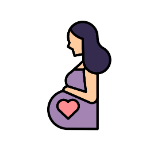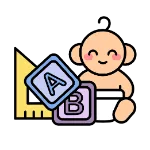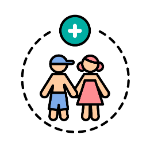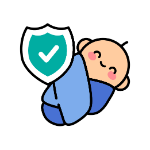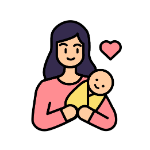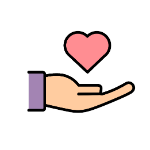
Childcare
10 Best Types Of Learning Toys For Your 1-Year-Old Baby 2025
10 min | Updated on 27-04-2023 by HappyPreggie
Play is an important part of childhood development because it gives your child different sensory, physical and cognitive experiences. These experiences build connections in their brain, which will then help them to develop physically, cognitively, socially and emotionally. However, choosing the method of play for your little one is no simple task.

Walking down the toy aisle (or browsing online) can be overwhelming because seemingly endless baby toys are available. It can be challenging to determine which toys will be the best for your 1-year-old baby and which they would enjoy for months or years to come. To make your search easier, we have curated the list of the 10 Best Types of Learning Toys For Your Baby!
Educational toys exercise your little one's cognitive abilities and encourage them to think outside the box. For 1-year-olds, these toys encourage them to explore their environment and discover new ideas and concepts, which aids their development.
Educational toys can also encourage your little ones to develop problem-solving, conflict-resolution and teamwork skills. It teaches your child the importance of sharing, helps develop their fine and gross motor skills and nurtures their creativity and imagination from a young age.

When picking a toy, check its age appropriateness and suitability with your child's skill level. It is important to buy toys recommended for your child's age because toys that are too difficult or advanced can frustrate your child. They may give up playing with them, leaving the toys in a box for many years. For example, buying small legos or puzzles may not suit your 1-year-old child because they lack fine motor skills. Moreover, children below 3 years old still put things into their mouths, and these small toy parts can become a choking hazard.
Choosing suitable toys can foster their development in many areas, for example, physical skills, confidence and communication. So, you will want to choose toys that will engage your little one's senses, but be careful not to overstimulate them! Too much noise or activity can overstimulate your baby, and they might cry, become very fussy or throw tantrums. One way you can help your overstimulated baby is by reducing the noise and activity or setting up a quiet activity instead.
Although every toy has its own recommended age, it may not be suitable for every child in that age group. That's why buying a toy based on your child's interests and abilities is more important than what's trendy or flashy. Before checking out, ask yourself questions like:
Now, in no particular order, are the 10 Best Types of Learning Toys For Your 1-Year-Old Baby!

Shape sorters utilise the skills your baby is learning at their age. Pegboard puzzles, nesting cups or blocks, and buckets with holes for different shaped blocks are the classic baby toys that are great for improving your little one’s hand-to-eye coordination, fine motor skills, problem-solving skills and cause-and-effect.

Pretend play toys help children learn how the world works by imitating the actions of you and other adults around them. Dolls and stuffed animals can encourage pretend play, such as by doing a tea party. It also aids social and emotional development by teaching your child how to express emotions and take great care of something precious to them.
If you notice your child playing with something and pretending to be something else, you will want to give them the related role-play toys to enhance their creativity.

Stacking toys, such as ring stackers, are very popular and widely sold. Your child can play with various sizes of interlocking rings, from big to small or small to big. These toys can help your child learn to organise correctly and enhance their cognitive skills, and it also helps in developing different thinking skills and improves mental and physical development.

Balls help build balance skills and allow your child to practise transferring an object from one hand to the other. Rolling a ball back and forth can also be an excellent way to build social bonds between you and your baby.
Your child needs to develop their gripping skills properly. You can give your child bigger plastic or softballs so they can grasp them easily. Not only will your child enjoy playing with it, but they can also learn many skills, such as throwing, catching and kicking. Playing with balls is also great for their motor skills and can enhance hand-to-eye coordination.

Pull-along toys may seem a little old-fashioned, but they promote many aspects of your toddler's development, like problem-solving, whole-body coordination and fine motor strength. It also plays a vital role in your little one's development as they are used to model the skills needed as adults.
Pull-along toys are an ideal starting point to facilitate the development-through-play. It comes in many styles and designs, such as animals, cars and trains. Pull-along toys have small wheels or movable feet and have a string attached to enable the pulling. So your child can pull the toy by the string, and the toy will roll behind as they walk or crawl.

You can break out those chunky crayons when your child hits the 1-year mark. Most children are ready to start colouring and scribbling between 12 to 15 months old, but like all child-related activities, learning to draw is a process that happens in phases, and this is just the beginning.
Open-ended toddler art activities allow your child to freely explore the materials and processes of drawing. You can set the focus on creative expression, so your child may learn how to draw vertical lines and circles and fill an area with colour first. The best way to do this is by supplying non-toxic, washable markers and crayons so your child can draw safely.

Board books help your child develop pre-reading skills such as letter recognition, sound discrimination and early language development. Board books are easy to handle and are typically geared toward younger toddlers. The fun features can make reading even more engaging. Reading together can promote a strong bond between you and your child while nurturing a love for reading.

Children over 12 months can already try out the classic rocking horses, starting with the smaller models, of course. Great for indoor and outdoor play, your child will enjoy every minute of improving their balance and coordination. However, you'll want to wait until your child reaches about 18 months old to be able to hold the handles on their own.
A rocking horse can be a gateway for all sorts of adventures for a creative and imaginative kid. They're also great for developing physical skills and balance and a huge boost of confidence for little ones to learn rock and roll.

Having musical toys allows for open-play engagement and natural learning. Children love dancing and moving to music, and silly songs lead to laughter and joy, while repetition songs can expose your child to vocabulary and rhymes.
Musical toys also boost cognitive skills and sensory development as it is through the patterns and rhythms the brain processes and transmits information faster and more efficiently. Children exposed to music perform better in language development, speech, listening and reading skills.

By 12 months old, your newly minted toddler may start climbing up stairs, and they'll continue exploring their environment. Climbing is an important physical milestone as it helps your child develop the coordination he needs to master skills like walking up steps later in life. Climbing can also be an excellent way for your little one to build strength, flexibility, and balance and help them learn about their surroundings and gain confidence.
Note that you will want to supervise them when they’re playing until they’re ready to climb independently. By their second birthday, your child should be able to walk up and down stairs on their own but may still hold on to the railing for support.
Play is often referred to as a way to relieve stress from serious learning. But for children, play is serious learning. When your child reaches 12 months old, new developments begin to unfold. Sweet milestones like first words balance the stress-inducing ones as your little one explores a new range of mobility and emotions. Learning toys give your child space for these developments and milestones to develop and grow, all at the leisurely pace of playtime.
Check out our blog on Introducing MUMU: From Feeding To Wooden Educational Toys Under One Wing. You can also read our blog on Best Baby Playmats You Can Find In Malaysia to make playing even more comfortable!
(Image credits to theAsianparent)
Walking down the toy aisle (or browsing online) can be overwhelming because seemingly endless baby toys are available. It can be challenging to determine which toys will be the best for your 1-year-old baby and which they would enjoy for months or years to come. To make your search easier, we have curated the list of the 10 Best Types of Learning Toys For Your Baby!
Importance Of Learning Toys
Educational toys exercise your little one's cognitive abilities and encourage them to think outside the box. For 1-year-olds, these toys encourage them to explore their environment and discover new ideas and concepts, which aids their development.
Educational toys can also encourage your little ones to develop problem-solving, conflict-resolution and teamwork skills. It teaches your child the importance of sharing, helps develop their fine and gross motor skills and nurtures their creativity and imagination from a young age.
Importance Of Choosing Age-Appropriate Toys
(Image credits to Insider)
When picking a toy, check its age appropriateness and suitability with your child's skill level. It is important to buy toys recommended for your child's age because toys that are too difficult or advanced can frustrate your child. They may give up playing with them, leaving the toys in a box for many years. For example, buying small legos or puzzles may not suit your 1-year-old child because they lack fine motor skills. Moreover, children below 3 years old still put things into their mouths, and these small toy parts can become a choking hazard.
Choosing suitable toys can foster their development in many areas, for example, physical skills, confidence and communication. So, you will want to choose toys that will engage your little one's senses, but be careful not to overstimulate them! Too much noise or activity can overstimulate your baby, and they might cry, become very fussy or throw tantrums. One way you can help your overstimulated baby is by reducing the noise and activity or setting up a quiet activity instead.
Although every toy has its own recommended age, it may not be suitable for every child in that age group. That's why buying a toy based on your child's interests and abilities is more important than what's trendy or flashy. Before checking out, ask yourself questions like:
- Will my child enjoy this?
- Will they be interested in this toy in the long run?
- Will they play with this toy more often than not?
- When would they no longer be interested in this toy?
- Can this toy help my child's developmental growth - individually and socially?
What To Consider Before Buying Baby Toys
- Choose toys that can be used in various ways.
- Look for toys that will grow with your child.
- Select toys that promote exploration and problem-solving.
- Look for toys that spark your child’s imagination.
- Give your child the chance to play with real-life stuff—or toys that look like the real object.
- Prepare some “getting ready to read” toys.
- Seek out toys that encourage your child to be active.
- Look for toys that enable cross-generational play.
Now, in no particular order, are the 10 Best Types of Learning Toys For Your 1-Year-Old Baby!
Best Types Of Toys For 1-Year-Old Baby
#1 Shape-Sorting Toys
(Image credits to Amazon)
Shape sorters utilise the skills your baby is learning at their age. Pegboard puzzles, nesting cups or blocks, and buckets with holes for different shaped blocks are the classic baby toys that are great for improving your little one’s hand-to-eye coordination, fine motor skills, problem-solving skills and cause-and-effect.
#2 Role-Play Toys
(Image credits to My Bored Toddler)
Pretend play toys help children learn how the world works by imitating the actions of you and other adults around them. Dolls and stuffed animals can encourage pretend play, such as by doing a tea party. It also aids social and emotional development by teaching your child how to express emotions and take great care of something precious to them.
If you notice your child playing with something and pretending to be something else, you will want to give them the related role-play toys to enhance their creativity.
#3 Stacking Toys
(Image credits to Homefurniturelife)
Stacking toys, such as ring stackers, are very popular and widely sold. Your child can play with various sizes of interlocking rings, from big to small or small to big. These toys can help your child learn to organise correctly and enhance their cognitive skills, and it also helps in developing different thinking skills and improves mental and physical development.
#4 Balls
(Image credits to Amazon)
Balls help build balance skills and allow your child to practise transferring an object from one hand to the other. Rolling a ball back and forth can also be an excellent way to build social bonds between you and your baby.
Your child needs to develop their gripping skills properly. You can give your child bigger plastic or softballs so they can grasp them easily. Not only will your child enjoy playing with it, but they can also learn many skills, such as throwing, catching and kicking. Playing with balls is also great for their motor skills and can enhance hand-to-eye coordination.
#5 Pull-Along Toys
(Image credits to POPSUGAR)
Pull-along toys may seem a little old-fashioned, but they promote many aspects of your toddler's development, like problem-solving, whole-body coordination and fine motor strength. It also plays a vital role in your little one's development as they are used to model the skills needed as adults.
Pull-along toys are an ideal starting point to facilitate the development-through-play. It comes in many styles and designs, such as animals, cars and trains. Pull-along toys have small wheels or movable feet and have a string attached to enable the pulling. So your child can pull the toy by the string, and the toy will roll behind as they walk or crawl.
#6 Art Materials
(Image credits to Firesara)
You can break out those chunky crayons when your child hits the 1-year mark. Most children are ready to start colouring and scribbling between 12 to 15 months old, but like all child-related activities, learning to draw is a process that happens in phases, and this is just the beginning.
Open-ended toddler art activities allow your child to freely explore the materials and processes of drawing. You can set the focus on creative expression, so your child may learn how to draw vertical lines and circles and fill an area with colour first. The best way to do this is by supplying non-toxic, washable markers and crayons so your child can draw safely.
#7 Board books
(Image credits to Smyths Toys)
Board books help your child develop pre-reading skills such as letter recognition, sound discrimination and early language development. Board books are easy to handle and are typically geared toward younger toddlers. The fun features can make reading even more engaging. Reading together can promote a strong bond between you and your child while nurturing a love for reading.
#8 Rocking Toys
(Image credits to Walmart)
Children over 12 months can already try out the classic rocking horses, starting with the smaller models, of course. Great for indoor and outdoor play, your child will enjoy every minute of improving their balance and coordination. However, you'll want to wait until your child reaches about 18 months old to be able to hold the handles on their own.
A rocking horse can be a gateway for all sorts of adventures for a creative and imaginative kid. They're also great for developing physical skills and balance and a huge boost of confidence for little ones to learn rock and roll.
#9 Musical Toys
(Image credits to ChildFun)
Having musical toys allows for open-play engagement and natural learning. Children love dancing and moving to music, and silly songs lead to laughter and joy, while repetition songs can expose your child to vocabulary and rhymes.
Musical toys also boost cognitive skills and sensory development as it is through the patterns and rhythms the brain processes and transmits information faster and more efficiently. Children exposed to music perform better in language development, speech, listening and reading skills.
#10 Climbing Toys
(Image credits to The Mummy Bubble)
By 12 months old, your newly minted toddler may start climbing up stairs, and they'll continue exploring their environment. Climbing is an important physical milestone as it helps your child develop the coordination he needs to master skills like walking up steps later in life. Climbing can also be an excellent way for your little one to build strength, flexibility, and balance and help them learn about their surroundings and gain confidence.
Note that you will want to supervise them when they’re playing until they’re ready to climb independently. By their second birthday, your child should be able to walk up and down stairs on their own but may still hold on to the railing for support.
Play is often referred to as a way to relieve stress from serious learning. But for children, play is serious learning. When your child reaches 12 months old, new developments begin to unfold. Sweet milestones like first words balance the stress-inducing ones as your little one explores a new range of mobility and emotions. Learning toys give your child space for these developments and milestones to develop and grow, all at the leisurely pace of playtime.
Check out our blog on Introducing MUMU: From Feeding To Wooden Educational Toys Under One Wing. You can also read our blog on Best Baby Playmats You Can Find In Malaysia to make playing even more comfortable!
Join the largest support network for family health and well-being. Ready to get started?
Get started
